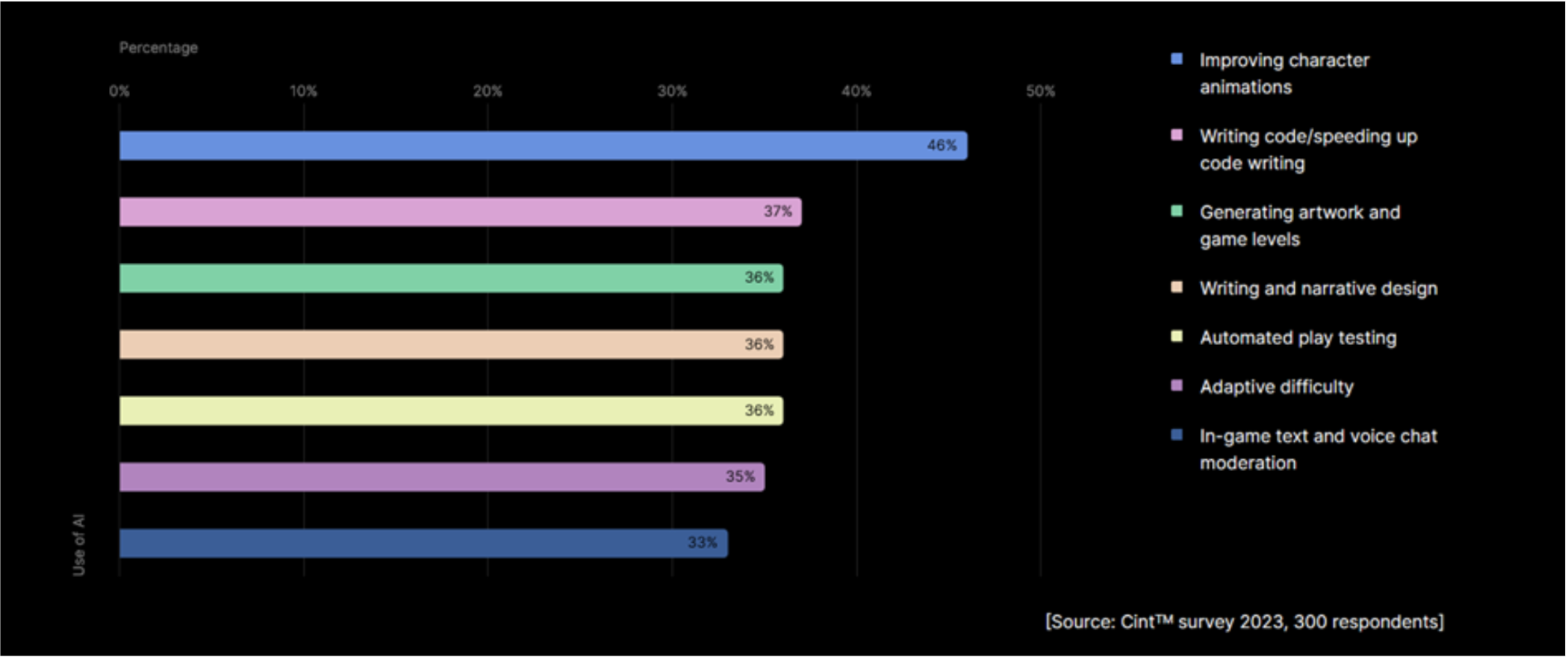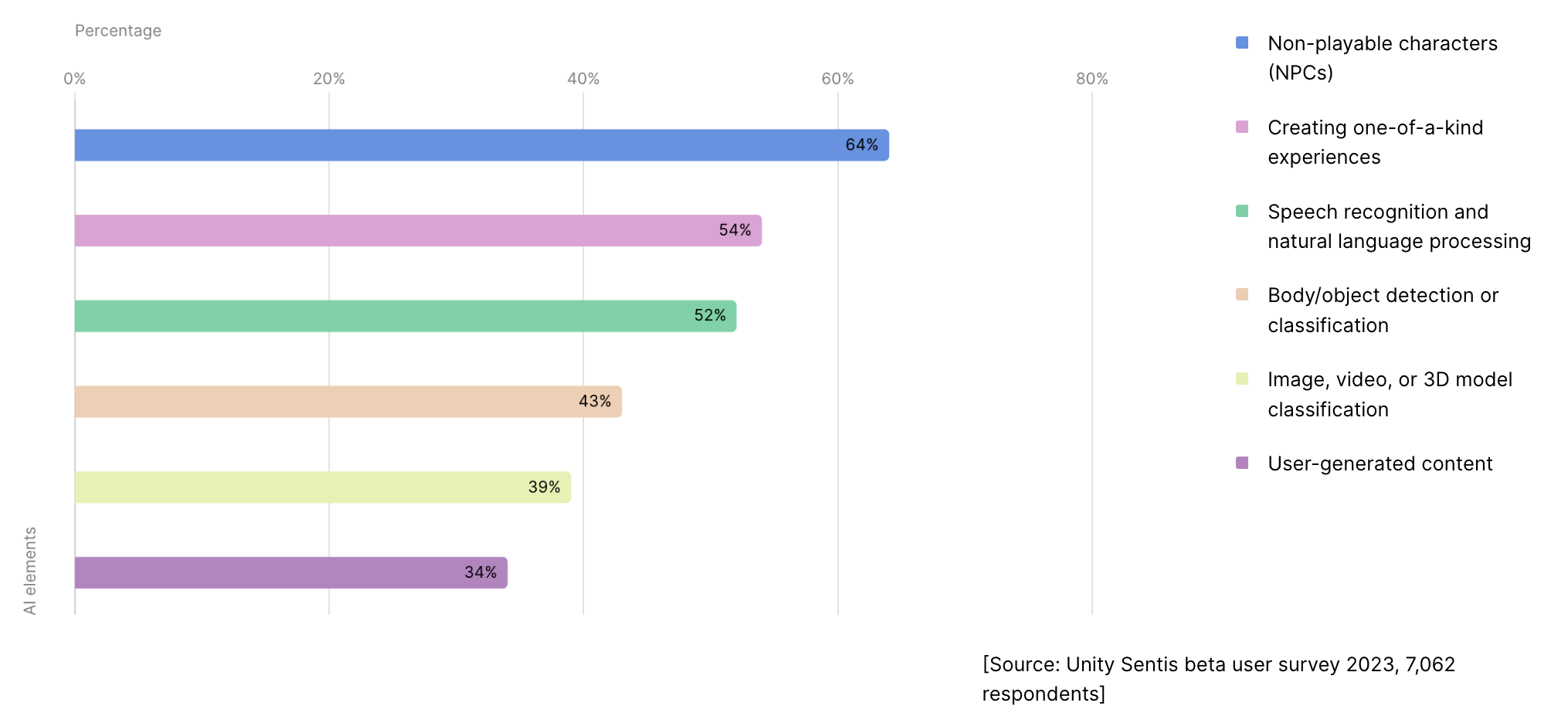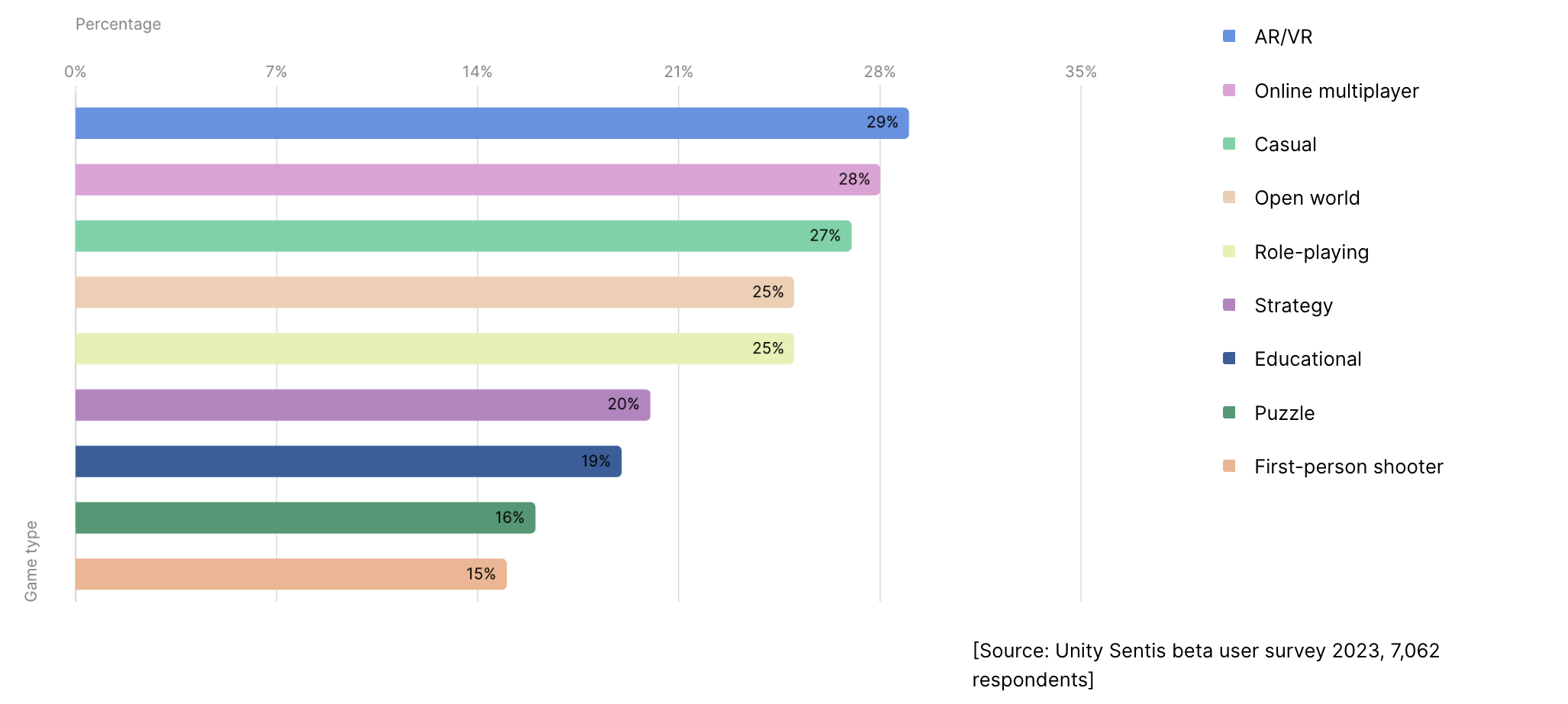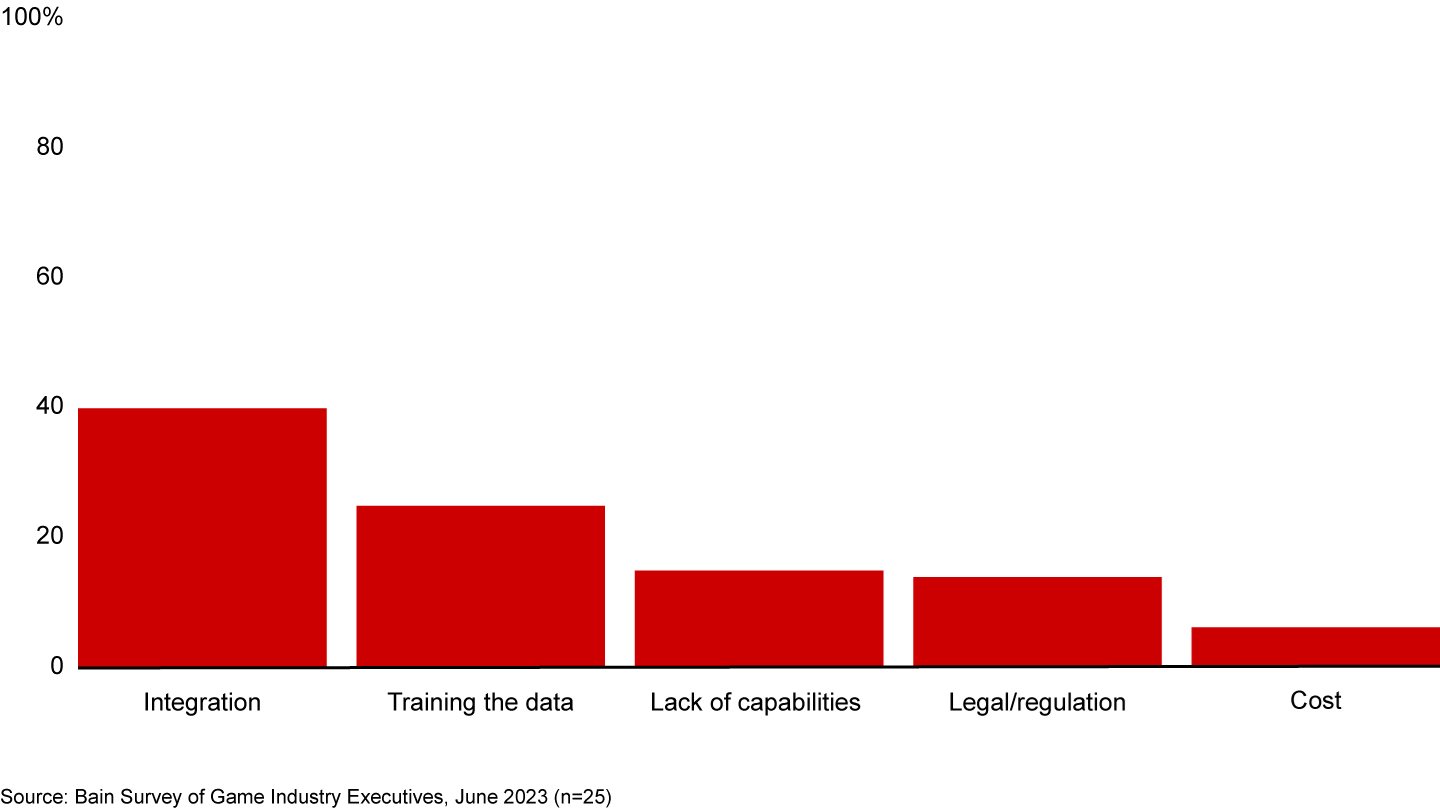Artificial intelligence has been an integral part of game development since its conception. Today, AI-powered NPCs and progressive gameplay adaptation based on player behavior are commonplace.
But that’s not all AI is capable of – and video game executives are keen to secure a competitive edge with the latest AI technologies. According to the 2024 Unity Gaming Report, 62% of gaming studios already use AI. Top use cases among developers are improving character animations, streamlining code writing, generating artwork, and writing and narrative design.

Generative AI (GenAI), however, marks a new era of AI integration in gaming. Although today it’s used to develop only around 5% of video game content, the share is expected to rise to 50% within five to ten years.

Here’s everything you need to know about AI use cases, trends, and application challenges in the gaming industry.
How AI Is Transforming Gaming: 6 Use Cases
Today, AI extends beyond powering basic NPC behavior. Here are the six recent use cases for AI in gaming.
Asset Generation
GenAI tools like Scenario and Didimo have already emerged to help smaller video game developers speed up development with AI-generated assets. The latter startup claims that Soleil Game Studios has already used its tool to create hundreds of NPCs.
Beyond generating NPCs and 3D assets, GenAI tools can also provide 2D art and textures based on natural-language prompts. For example, Unity Muse allows developers to generate “game-ready” textures and 2D sprites right in the Unity Editor.
Procedural Content Generation
AI is key to enabling procedural in-game content generation, which allows for algorithmically generating unique 3D models, levels, and whole locations. This way, the gameplay experience becomes more unpredictable and diverse.
No Man’s Sky (2016), for example, made its open world virtually endless with procedural content generation. The game generates custom fauna, flora, climate, and geology to create new planets for players to explore.
Code Generation, Real-Time Optimization & Testing
AI and machine learning can speed up and streamline debugging, all while making it more cost-efficient. In production, the two technologies are already part of automated testing and QA tools. For example, both Google and Electronic Arts patented AI use for game testing.
A new leap in AI tools, coding copilots, can make development even more efficient. For example, GitHub Copilot can provide real-time optimization suggestions, generate code snippets, and hunt down bugs – and it comes with an in-built vulnerability prevention system, too. According to GitHub’s own research, the copilot speeds up development by 55%.
Dialogue Generation
Large language models have emerged as a potential time-saver in NPC dialogue writing. They can generate responses and lines based on the provided prompts. As a result, video game writers can focus on crafting the dialogue that drives the narrative forward.
For example, Ubisoft unveiled Ghostwriter, its own AI dialogue generator, in March 2023. The tool generates the first draft of barks – i.e., NPCs’ responses during triggered events. Writers then revise and refine the draft faster than creating it from scratch.
Gameplay Personalization
Beyond generating game content and code, AI has the potential to affect the core of gameplay. Using predictive analytics for gaming, for example, allows for adapting the difficulty levels to player performance, tailoring the experience to every player’s capabilities.
Ergo, AI can lower the difficulty for players struggling with a particular part of gameplay to prevent rage quitting and improve player retention. At the same time, it can increase the difficulty for those quickly leveling up to keep the game interesting and challenging.
On top of that, AI can power personalized recommendations for gaming, such as gameplay hints showing on the screen after the player fails to execute a certain action.
Smart Non-Playable Characters
64% of AI adopters in the gaming industry already leverage the technology to create NPCs, according to the 2024 Unity Gaming Report. While AI-powered NPC behavior is hardly a new development, GenAI is poised to pave the way for unscripted intelligent NPCs.

Replica’s Matrix Awakens demo showcased smart NPCs in 2023. The NPCs used AI voice generation and OpenAI language generation to dynamically respond to the player’s actions, coming up with responses on the spot.
3 Trends of AI Use in Gaming to Keep an Eye On
Where is the AI rush headed in the gaming industry? Here are the three trends that might give you a clue.
GenAI Is the New It
GenAI powers many of the innovations mentioned above, from smart NPCs and procedural content generation to gameplay personalization and asset generation. Leading companies like Ubisoft and Blizzard have already embraced the technology, along with 63% of AI-adopting developers who leverage generative tools for asset generation.
AR/VR & Online Multiplayer Games Lead the Way
According to the 2024 Unity Gaming Report, AI is most commonly used in AR/VR and online multiplayer games, followed closely by their casual counterparts. First-person shooters, puzzle games, and educational games utilize AI the least.

GenAI Is Poised to Transform Production
At the moment, video game developers leverage GenAI predominantly in pre-production. However, video game executives expect it to change within the next five to ten years.
According to a Bain Survey, more than half of executives expect GenAI to become a vital tool in production. The use cases here include NPC and story generation, game asset generation, live ops support, and user-generated content created with GenAI tools.

Gaming Companies Already Leveraging AI
Which video game developers are already leveraging AI? Here are three case studies worth your attention.
Squanch Games
Squanch Games is the company behind High on Life (2022), a comedic first-person shooter created by Justin Roland, the co-creator of Rick and Morty. This video game title leveraged AI in one pioneering way: voice acting. Yet, the AI didn’t completely substitute voice actors; instead, AI was used to prototype some voices. (However, one minor role was voiced by AI.)
Besides that, Justin Roland also stated that the team used Midjourney to create in-game assets, such as movie posters in the protagonist’s room.
Straight4 Studios
Straight4 Studios is the developer behind an upcoming racing simulator, GTRevival, currently slotted for release during the 2024 holiday season. The video game is reported to leverage AI to synthesize commentary based on the player’s actions in real time, making it an example of AI-powered real-time optimization.
Blizzard Entertainment
Blizzard Entertainment created a custom visual content generator based on proprietary content from its previous titles, as the New York Times reported in May 2023. The tool, dubbed Blizzard Diffusion, is meant to turn natural-language prompts into art, be it environment concepts or NPCs.
That said, the same NYT article mentions that Blizzard had to give up on its other AI tool. The said tool used proprietary machine learning technology to create environmental textures. It was dropped because using it turned out to be too time-consuming for artists.
5 Current Challenges of Using AI in Gaming
While AI integration in gaming isn’t a new development, implementing the newest technological leaps can be challenging for the following five reasons.

GenAI Integration
When it comes to GenAI, integrating it with existing game development tools is the number one challenge for video game executives. While GenAI tools have been introduced to editors like Unity Editor (e.g., Unity Muse), companies working with their proprietary engines must invest in AI integration. This goes for companies like id Software (id Tech 7 engine, written in C++) and 4A Games (4A Engine), for example.
Training Data
Second on the list of GenAI challenges, training the GenAI tools for specific application cases requires data – a lot of it. The data has to reflect the development company’s style and, in the case of working within a franchise, match its style, as well.
The solution is simple for larger companies: train the data on its previously created assets. Their smaller competitors, however, don’t have the same wealth of proprietary data to power their AI tools, forcing them to turn to off-the-shelf solutions.
Copyright Concerns
GenAI tools require vast pools of training data to learn to produce the required content, be it code or visuals. If the training data comes from external sources without prior approval, this may leave the company open to legal action.
For now, it’s unclear whether AI-generated content can be considered plagiarism and whether using publicly available external data for training constitutes copyright infringement or fair use. Getty Images’ lawsuit against Stable Diffusion and OpenAI’s trial, however, may set the legal precedent on the latter matter.
Privacy Concerns
Gaming companies have to collect swaths of data to analyze player behavior and offer personalized gameplay experiences – and players are mindful of that.
More than half of Gen X (70%), Millennial (66%), and Gen Z (63%) players are concerned about data privacy in video games. Combined with increasingly restrictive privacy legislation (e.g., the General Data Privacy Regulation in the EU), companies have to tread carefully when processing user data with AI tools.
Evolving Legislative Landscape
The use of AI and GenAI in particular remain largely unregulated; however, it is bound to change soon. The European Parliament recently adopted the Artificial Intelligence Act, for instance. Gaming companies are likely to be concerned by the Act’s transparency requirements for general-purpose AI systems.
What the Future Holds for AI in Gaming
AI-driven game design and development are here to stay; that much is clear. Making predictions on where the technology is going, however, should be done carefully as the accelerating technological change means trends may shift in a matter of a year or two.
That said, it’s not too outlandish to say that AI is likely to power a new generation of games with hyper-personalized gameplay, more lifelike NPCs, boundless open worlds, and unique, randomly generated game levels.
Although GenAI is expected to add trillions of U.S. dollars to the global economy via productivity enhancement across industries, video game executives are skeptical about it being a cost-saving opportunity. Only 20% of them expect GenAI to reduce costs. Instead, they view it as an opportunity to speed up time-to-market and improve game quality.
Is Your Enterprise Ready for AI Integration in Gaming?
Implementing AI strategically means moving in phases to:
- Maximize the increase in net new value pools
- Move away from transactional and episodic engagement to a personalized and continuous one.
To create an effective AI strategy:
- Explore AI use cases in gaming, their underlying technologies, which issues they can solve at your organization, and what benefits you stand to reap from them
- Analyze the organization’s priorities and capabilities to discover which issues are the most pressing to solve
- Ensure you have the right resources to implement the AI system
- Define the clear objectives for AI implementation and set the metrics to be tracked
- Find the right partners and vendors to help you implement your strategy
- Create a roadmap that prioritizes fast wins with added value for the organization
- Outline the data, algorithms, infrastructure, and talent required for implementing those fast wins
- Secure the buy-in for the AI strategy among key stakeholders
- Ensure your teams have the skills to make the most out of the new tools
- Establish the ethical guidelines for AI use
- Analyze the initiative’s outcomes and adapt your strategy accordingly.
Don’t know where to start with AI integration in gaming? We can help you identify the opportunities with the highest added value and impact with our AI Design Sprint service. During the sprint, we’ll identify the feasibility and costs of potential AI initiatives, reduce uncertainty and analyze risks, outline how to speed up AI implementation and evaluate proof of value.
Get in touch with us to discuss how we can help you gain a competitive edge with state-of-the-art AI capabilities.
About Neurons Lab

Neurons Lab is an AI consultancy that provides end-to-end services – from identifying high-impact AI applications to integrating and scaling the technology. We empower companies to capitalize on AI’s capabilities.
As an AWS Advanced Partner, our global team comprises data scientists, subject matter experts, and cloud specialists supported by an extensive talent pool of 500 experts. We solve the most complex AI challenges, mobilizing and delivering with outstanding speed to support urgent priorities and strategic long-term needs.
Ready to leverage AI for your business? Get in touch with the team here.











